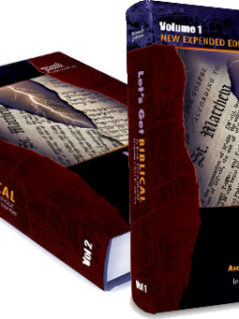Question:
I want to first commend you on your web site which is laid out quite well and has helped me understand more about traditional Jewish thinking on Christ. Although I am a born again Christian, I do not support groups such as the Messianics who sit on the fence regarding Judaism and Christianity. You either follow Judaism or Christianity; you can’t pretend to follow both at the same time. This has led to Jews for Jesus following rabbinic customs that are not a part of the teachings of Christ.
With that said, my question to you is: Why have the Jewish people rejected Jesus as their sacrificial lamb who is the sin bearer for mankind when the atoning blood of Jesus is so everpresent in the Paschal lamb in the Book of Exodus. I ask this question because you are a rabbi and profess to believe in the teachings of the Old Testament; so how is it that you do not see the atonement of the blood of the lamb which was placed on the doorposts that first Passover Seder night in Egypt? I look forward to your answer.
Answer:
Evangelical Christians often draw a comparison between the Paschal Lamb and Jesus, insisting that the former foreshadows the latter. This idea is advanced in the New Testament, particularly in the fourth Gospel, where John portrayed Jesus as the fulfillment of the Passover lamb. Yet how valid a point is this? What is the meaning of this holiday sacrifice? Is there a relationship between this festival offering and atonement for sin?
The Bible relates in Exodus 12:3-13 that as the Jewish people were preparing themselves for the momentous Exodus from Egypt, God commanded them to slaughter a year-old sheep or goat on the 14th day of the first month (Nissan). They were to place its blood on the outside doorposts of their homes. Because Christians insist that the blood of the Paschal lamb foreshadowed the atonement of the blood of Jesus at Calvary, it behooves us to question the soundness of this claim.
The Passover lamb did not atone for sin and accordingly, this idea is nowhere to be found in the Jewish Scriptures. It goes without saying that the notion that the Paschal Lamb is a representation of a crucified savior or an atonement is alien to the teachings of the Torah and is not even mentioned by the first three Gospels.
A mindful study of the Jewish Scriptures reveals that the Paschal Lamb was alluded to long before the Exodus from Egypt. Centuries earlier, Abraham’s faith was tested by God when he commanded him to sacrifice his beloved son Isaac. Genesis 22:7-8 relates that as the two ascended Mount Moriah together, Isaac asked his father,
“Here is the fire and the wood, but where is the lamb for the offering?” Abraham then replied, “God will see to a lamb for an offering, my son.”
(Genesis 22:7-8)
The question that comes to mind is, what happened to that lamb that Abraham promised? A few verses later we find that ram was sacrificed rather than a lamb! Where was the lamb to which Abraham was prophetically referring?
The answer of course is that our father Abraham was prophetically alluding to the Paschal lamb. Just as God tested Abraham’s faith to demonstrate his worthiness to be the father of the chosen people, the young Jewish nation also had to have their faith tested to show their worthiness to participate in the exodus from Egypt, receive the Torah at Mount Sinai, and emerge as the progenitors of the covenant people who would forever be known as “a light to the nations.”
During the period of the Exodus in Ancient Egypt, the lamb was deified and worshiped as a god. By Egyptian law, it was therefore forbidden to harm a lamb in any way; such an act was considered a crime punishable by death.
For this reason, Moses refused Pharaoh’s initial offer that the Jews bring their sacrifice to God while remaining in Egypt, following the third plague of lice. Moses explained to Pharaoh that it would be impossible for his people to sacrifice these animals in this land because the Egyptians would execute us for carrying out this ceremony (Exodus 8:25-26).
The Almighty, therefore, tested the faithfulness of the Jewish people by commanding them to kill Egypt’s cherished god, and place the lamb’s blood on their doorposts, displayed for all of their neighbors to see. Only those Israelites who, like Abraham, demonstrated that they feared nothing but the God of Israel were deemed worthy to have their homes “passed over” during the tenth and final plague.
It is worth noting that the synoptic gospels, i.e. the gospels of Matthew, Mark, and Luke, do not associate Jesus with the Paschal Lamb. The Book of John, on the other hand, draws a clear link between the two (John 1:29-34). The synoptic Gospels insist that Jesus was crucified on the first day of Passover – the 15th day of Nissan. Written several decades after the synoptic Gospels, th John’s author accordingly has Jesus crucified on the eve of Passover, the 14th day of Nissan, when the lambs were slaughtered. As a result, the Passover Seder is noticeably absent in John’s Passion Narrative.
Sincerely yours,
Rabbi Tovia Singer

